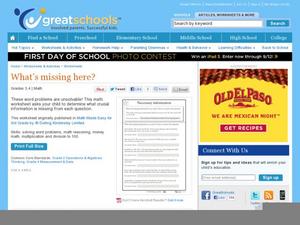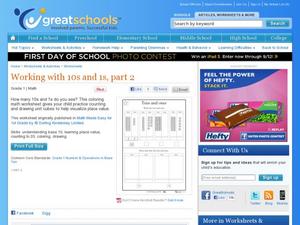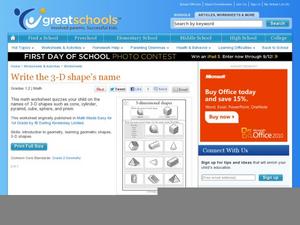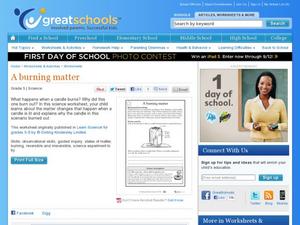Curated OER
Volume of Cubes
Practice finding cubic volume with nine illustrations. Different shapes composed of 1 cm cubes prompt fifth graders to calculate the volume of each shape. An example at the top of the page guides learners through the mathematical process.
Curated OER
What's Missing Here? - Necessary Information
Take your third graders' problem-solving skills to the next level. Six word problems need a solution, but they aren't solvable in their current forms. Learners explain the piece of missing information that they need to solve the word...
Curated OER
What's the Perimeter?
Find the perimeter of squares and rectangles with a straightforward worksheet. An example at the top of the page shows third graders how to find the perimenter, along with the addition problem necessary to find it. Pupils then work on...
Curated OER
What's the Average?
Practice finding the averages of different groups of numbers. Third graders review an example at the top of the page, then find the averages of fourteen groups of numbers (with eight numbers in each group). The instructional activity is...
Curated OER
What's the Time? #2
Challenge your class's time-telling skills with fifteen analog clocks, all with blank faces. They write the hands in the correct places, all with times to the nearest five minutes. An easy way to extend this assignment would be a group...
Curated OER
Telling Time
Here's a great way for young time tellers to practice writing reading time words, then writing them out correctly. There are 15 watch faces with the time words above them. Kids write the actual time numbers, with the colon in between...
Curated OER
Where's That Shape?
Your kindergartners know their shapes - but can they identify their locations? A 3x3 grid contains geometric shapes such as diamonds, circles, and hexagons, and pupils locate the shapes within the grid. Which shape is underneath the...
Curated OER
What's Your Favorite Fruit?
A sweet activity to challenge your first graders! The picture graph displays a class's favorite fruits. Young learners solve various problems with the data, including counting the amounts of each kind of fruit, and interpreting which...
Curated OER
Which Coin?
Manage your money with change purses and piggy banks. Once they match different coins to corresponding price tags, first and second graders add the amounts of change in each illustration. For extra practice, bring in small items for kids...
DK Publishing
Which is Biggest?
Help kindergartners determine which picture is biggest, tallest, longest, and thinnest! After studying four sets of pictures, kids choose the picture that is indicated in the instructions. Color the page once they're done for extra fun!
Curated OER
Who Has More Money?
Coloring and money combine in this fun instructional activity! First and second graders count the amounts of money represented in each, and then color the person or animal who has the most money. They then draw the correct coins to add...
Curated OER
Which One's Different?
One of these things is not like the others! Preschoolers identify which sock and glove is different from the rest, and draw a ring around the outlier. Then, they draw a sock and glove that are different from given pictures. Color the...
DK Publishing
Who's First?
Put ribbons, rabbits, and shapes in order with a number sequence activity. Three different activities reinforce counting and number sequence, as kindergartners color particular items and identify the first, second, and third in various...
Curated OER
Working with 10s and 1s
Can your first graders count by 1s? What about by 10s? Use this graphic learning exercise to help youngsters visualize place value and counting. They count how many sets of 1s or 10s they see, then they draw a given number of 1s or 10s....
Curated OER
Working with 10s and 1s, Part 2
Practice place value by visualizing 10s and 1s. First graders count the cubes in each place, then write the total number at the bottom. In one particularly helpful section, they draw the cubes that will add up to a given number. Bring in...
Curated OER
Working with Coins
Count the correct change with a money math worksheet! Given certain coins, second and third graders add and subtract amounts of money to find the correct change. The worksheet uses pennies, nickels, dimes, quarters, half dollars, and...
Curated OER
Write the 3D Shape's Name
Can your first graders identify a cone? What about a cube? Or a prism? Help them find the differences between these shapes with this worksheet, which provides a word bank for three-dimensional shapes. For extra practice, bring in...
Curated OER
Write the 3-D Shape's Name, Part 2
Geometry can be fun when you know the shapes! Twelve pictures of geometric shapes, including cones, pyramids, and spheres, prompt first graders to write the name of each shape in the space provided. Use the activity as a quiz or homework...
Curated OER
Working with Coins #2
Practice money math with a helpful worksheet. Illustrations of coins, along with word problems, keep second graders focused on adding and subtracting different amounts of money. An excellent homework assignment to reinforce your money...
DK Publishing
Writing Equivalent Number Sentences
Connect the four operations with a series of number sentences. After studying the examples at the top of the page, third graders find ways to write related number sentences for addition, subtraction, multiplication, and division...
Curated OER
Writing Numbers
A multi-faceted approach to place value! Third graders write four-digit numbers, as well as interpreting the written forms of large numbers. Use the resource as a unit assessment, or in parts as a warm-up activity throughout the week.
DK Publishing
A Burning Matter
The process of fire requires oxygen, heat, and fuel. Take one of those away, and fire ceases to exist. That's the idea behind this worksheet which portrays a candle burning inside an upside down jar. Pupils answer a couple of questions...
Curated OER
How Does Water Cool?
How fast does water cool? First fifth graders will draw a line on a graph that predicts how fast they think water can cool from boiling. Then they plot the actual data on the same graph to see if their estimate was correct.
Alabama Learning Exchange
Bloodstain Pattern Doesn't Lie......
An interesting instructional activity on hypothesizing about the diameter of a drop of blood that is splattered. To test their theories, learners work in groups to make blood droplets splatter from different heights. They use graphed...
Other popular searches
- Calculus Limits
- Pre Calculus Limits
- Limits and Continuity
- Pre Calculus With Limits
- Legal Limits
- Limits on Populations
- Functions and Limits
- Limits to Population Growth
- Limits Composite Functions
- Sexual Limits
- Constitutional Limits
- Pre Calculus Limits

























